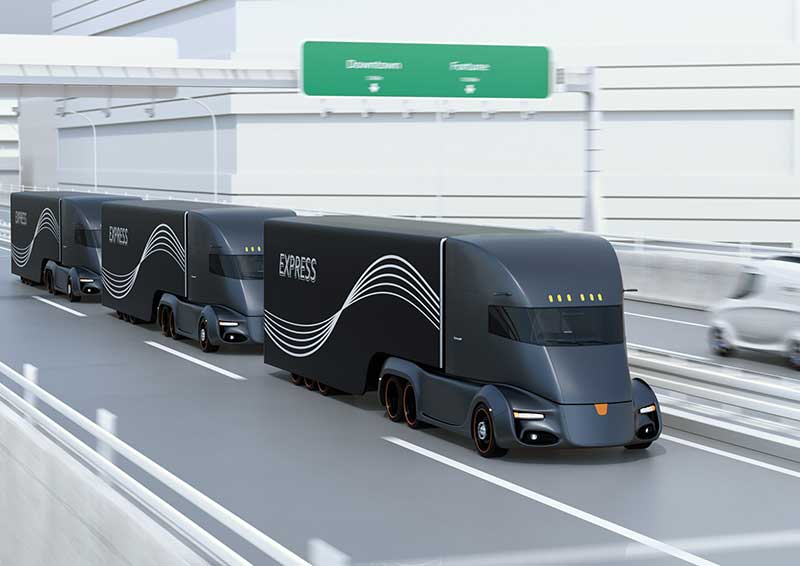Platooning
Contents |
[edit] Introduction
Up to three trucks travelling close together, known as ‘platooning’, is being looked at by the National Infrastructure Commission (NIC) as part of a study into freight in the UK.
Referred to variously as ‘HGV’, ‘truck’ and ‘lorry’ platoons – these are convoys of up to three heavy goods vehicles, travelling close together with acceleration and braking controlled by the lead vehicle and using smart technologies to mutually communicate. Three vehicle platoons are in the region of 50 m long.
Highways England and the Department for Transport are currently conducting a study which will lead to on-road platooning trials later in 2018. This is an £8 million information generating exercise to underpin future policy decisions.
[edit] Benefits of heavy goods vehicle platooning
Roads are the primary method of transporting freight within the UK. In 2015, just over three quarters (76%) of all goods moved by road with the remainder by water (15%) and rail (9%).
The UK strategic road network faces a range of challenges from loading and congestion, its relatively unplanned nature and resulting high transport emissions. Reducing the volume, and increasing the efficiency of road freight is essential.
A range of potential benefits from HGV platooning have been suggested by the European Automobile Manufacturers Association:
- Lower fuel consumption and consequently lower fuel cost - HGVs drive closer together at a constant speed improving aerodynamics, with less braking and accelerating.
- Potential to reduce CO2 emissions by up to 10%.
- More efficient road use, reducing congestion (thus improving air quality), and optimising delivery of goods.
[edit] Challenges of going down the platooning road
The UK strategic road network has grown gradually and organically over time. It has not been as heavily planned as other countries and on key stretches is heavily loaded.
It is interspersed with junctions and slip roads, often quite close together. This automatically creates challenges for HGV platoon trails, identifying how to manage other vehicles’ access to the road. The perception of 50 m HGV platoons as a long road block and the time needed to overtake (based on margin speeds) are still significant issues.
This could be addressed by automated coupling/uncoupling of HGVs in the platoon to accommodate access from slip roads. Separation from other road traffic has also been suggested but it is as yet unclear what this might look like and what the economic implications might be. Its potential may be most fully realised in a Level 5 (full autonomy) vehicle autonomy environment.
A broad range of unknowns exist, including how HGV platoons may impact impact upon existing infrastructure and design requirements for future infrastructure.
It is possible that, should HGV platooning be deployed, assumptions will have to be changed about the vibration impacts on bridges or road surface deterioration rates.
This article was originally published here on 6 March 2018 by ICE. It was written by Kelly Forbes, ICE Policy Manager.
--The Institution of Civil Engineers
[edit] Related articles on Designing Buildings Wiki
Featured articles and news
Latest Build UK Building Safety Regime explainer published
Key elements in one short, now updated document.
UKGBC launch the UK Climate Resilience Roadmap
First guidance of its kind on direct climate impacts for the built environment and how it can adapt.
CLC Health, Safety and Wellbeing Strategy 2025
Launched by the Minister for Industry to look at fatalities on site, improving mental health and other issues.
One of the most impressive Victorian architects. Book review.
Common Assessment Standard now with building safety
New CAS update now includes mandatory building safety questions.
RTPI leader to become new CIOB Chief Executive Officer
Dr Victoria Hills MRTPI, FICE to take over after Caroline Gumble’s departure.
Social and affordable housing, a long term plan for delivery
The “Delivering a Decade of Renewal for Social and Affordable Housing” strategy sets out future path.
A change to adoptive architecture
Effects of global weather warming on architectural detailing, material choice and human interaction.
The proposed publicly owned and backed subsidiary of Homes England, to facilitate new homes.
How big is the problem and what can we do to mitigate the effects?
Overheating guidance and tools for building designers
A number of cool guides to help with the heat.
The UK's Modern Industrial Strategy: A 10 year plan
Previous consultation criticism, current key elements and general support with some persisting reservations.
Building Safety Regulator reforms
New roles, new staff and a new fast track service pave the way for a single construction regulator.
Architectural Technologist CPDs and Communications
CIAT CPD… and how you can do it!
Cooling centres and cool spaces
Managing extreme heat in cities by directing the public to places for heat stress relief and water sources.
Winter gardens: A brief history and warm variations
Extending the season with glass in different forms and terms.
Restoring Great Yarmouth's Winter Gardens
Transforming one of the least sustainable constructions imaginable.
























